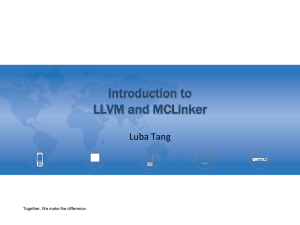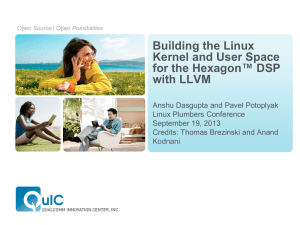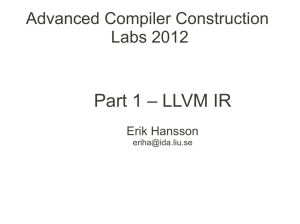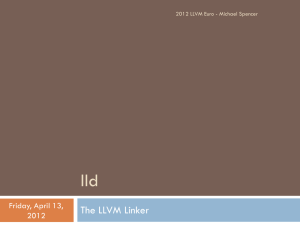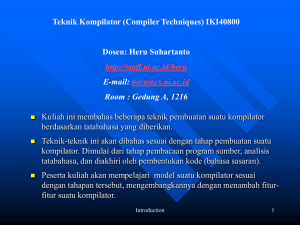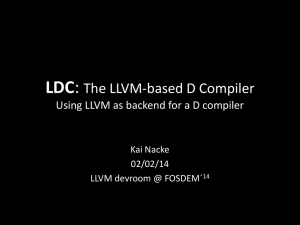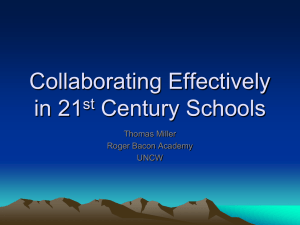Powerpoint - University of Michigan
advertisement
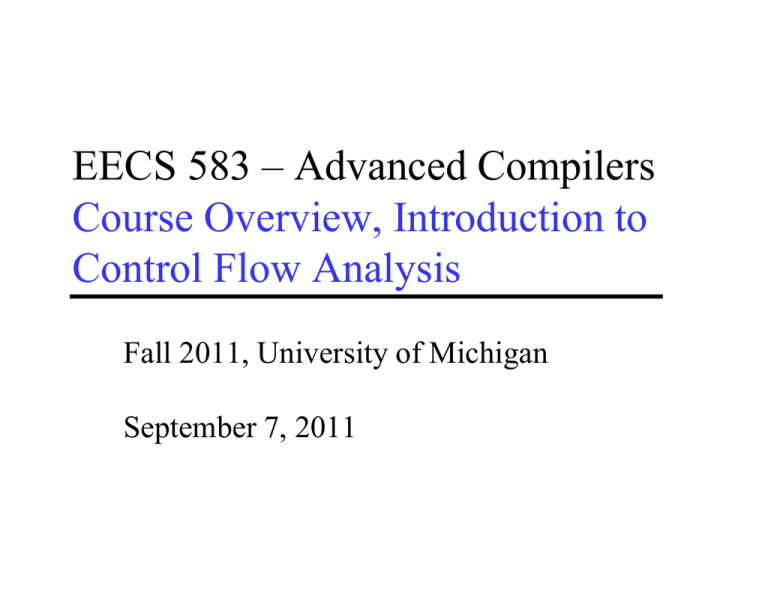
EECS 583 – Advanced Compilers
Course Overview, Introduction to
Control Flow Analysis
Fall 2011, University of Michigan
September 7, 2011
About Me
Mahlke = mall key
» But just call me Scott
10 years here at Michigan
» Compiler guy who likes hardware
» Program optimization and building custom hardware
for high performance/low power
Before this – HP Labs
» Compiler research for Itanium-like processors
» PICO – automatic design of NPAs
Before before – Grad student at UIUC
Before ^ 3 – Undergrad at UIUC
-1-
Class Overview
This class is NOT about:
»
»
»
»
»
»
Programming languages
Parsing, syntax checking, semantic analysis
Handling advanced language features – virtual functions, …
Frontend transformations
Debugging
Simulation
Compiler backend
»
»
»
»
Mapping applications to processor hardware
Retargetability – work for multiple platforms (not hard coded)
Work at the assembly-code level (but processor independent)
Speed/Efficiency
How to make the application run fast
Use less memory (text, data), efficiently execute
Parallelize
-2-
Background You Should Have
1. Programming
»
»
»
»
Good C++ programmer (essential)
Linux, gcc, emacs
Debugging experience – hard to debug with printf’s alone
Compiler system not ported to Windows
2. Computer architecture
» EECS 370 is good, 470 is better but not essential
» Basics – caches, pipelining, function units, registers, virtual
memory, branches, multiple cores, assembly code
3. Compilers
» Frontend stuff is not very relevant for this class
» Basic backend stuff we will go over fast
Non-EECS 483 people will have to do some supplemental reading
-3-
Textbook and Other Classroom Material
No required text – Lecture notes, papers
LLVM compiler system
» LLVM webpage: http://www.llvm.org
» Read the documentation!
» LLVM users group
Course webpage + course newsgroup
» http://www.eecs.umich.edu/~mahlke/courses/583f11
» Lecture notes – available the night before class
» Newsgroup – ask/answer questions, GSI and I will try
to check regularly but may not be able to do so always
http://phorum.eecs.umich.edu
-4-
What the Class Will be Like
Class meeting time – 10:30 – 12:30, MW
» 2 hrs is hard to handle
» We’ll stop at 12:00, most of the time
Core backend stuff
» Text book material – some overlap with 483
» 2 homeworks to apply classroom material
Research papers
» I’ll present research material along the way
» However, its not a monologue, you are expected to
participate in the discussion
» Students will be asked to submit summaries/opinions
about papers
-5-
What the Class Will be Like (2)
Learning compilers
» No memorizing definitions, terms, formulas,
algorithms, etc
» Learn by doing – Writing code
» Substantial amount of programming
Fair learning curve for LLVM compiler
» Reasonable amount of reading
Classroom
» Attendance – You should be here
» Discussion important
Work out examples, discuss papers, etc
» Essential to stay caught up
» Extra meetings outside of class to discuss projects
-6-
Course Grading
Yes, everyone will get a grade
» Distribution of grades, scale, etc - ???
» Most (hopefully all) will get A’s and B’s
» Slackers will be obvious and will suffer
Components
»
»
»
»
»
Midterm exam – 25%
Project – 45%
Homeworks – 10%
Paper summaries – 10%
Class participation – 10%
-7-
Homeworks
2 of these
» Small/modest programming assignments
» Design and implement something we discussed in class
Goals
» Learn the important concepts
» Learn the compiler infrastructure so you can do the project
Grading
» Good, weak effort but did something, did nothing (2/1/0)
Working together on the concepts is fine
» Make sure you understand things or it will come back to bite you
» Everyone must do and turn in their own assignment
-8-
Projects – Most Important Part of the Class
Design and implement an “interesting” compiler technique
and demonstrate its usefulness using LLVM
Topic/scope/work
» 2-3 people per project (1 person , 4 persons allowed in some cases)
» You will pick the topics (I have to agree)
» You will have to
Read background material
Plan and design
Implement and debug
Deliverables
»
»
»
»
Working implementation
Project report: ~5 page paper describing what you did/results
15-20 min presentation at end (demo if you want)
Project proposal (late Oct) and status report (late Nov) scheduled with
each group during semester
-9-
Types of Projects
New idea
» Small research idea
» Design and implement it, see how it works
Extend existing idea (most popular)
» Take an existing paper, implement their technique
» Then, extend it to do something interesting
Generalize strategy, make more efficient/effective
Implementation
» Take existing idea, create quality implementation in LLVM
» Try to get your code released into main LLVM system
Using other compilers is possible but need a good
reason
- 10 -
Topic Areas (You are Welcome to Propose Others)
Automatic parallelization
» Loop parallelization
» Vectorization/SIMDization
» Transactional
memories/speculation
» Breaking dependences
Instruction prefetching
Data prefetching
Use of scratchpad memories
Data layout
Power
» Instruction scheduling techniques
to reduce power
» Identification of narrow
computations
Memory system performance
»
»
»
»
Streaming/GPUs – StreamIt
compiler
» Stream scheduling
» Memory management
» Optimizing CUDA programs
Reliability
For the adventurous - Dynamic
optimization
» However, LLVM dynamic system
is not stable
» Run-time parallelization or other
optimizations are interesting
» Catching transient faults
» Reducing AVF
» Application-specific techniques
- 11 -
Class Participation
Interaction and discussion is essential in a
graduate class
»
»
»
»
Be here
Don’t just stare at the wall
Be prepared to discuss the material
Have something useful to contribute
Opportunities for participation
» Research paper discussions – thoughts, comments, etc
» Saying what you think in project discussions outside
of class
» Solving class problems
» Asking intelligent questions
- 12 -
GSI
Daya Khudia (dskhudia@umich.edu)
Office hours
» Tuesday, Thursday, Friday: 3-5pm
» Location: 1620 CSE (CAEN Lab)
LLVM help/questions
But, you will have to be independent in this class
»
»
»
»
»
Read the documentation and look at the code
Come to him when you are really stuck or confused
He cannot and will not debug everyone’s code
Helping each other is encouraged
Use the phorum (Daya and I will monitor this)
- 13 -
Contact Information
Office: 4633 CSE
Email: mahlke@umich.edu
Office hours
» Mon/Wed right after class in 3150 Dow
» Wed: 4:30-5:30
» Or send me an email for an appointment
Visiting office hrs
» Mainly help on classroom material, concepts, etc.
» I am just learning LLVM myself, so likely I cannot
answer any non-trivial question
» See Daya for LLVM details
- 14 -
Tentative Class Schedule
Week
1
2
3
4
5
6
7
8
9
10
11
12
13
14
15
Date
Sept 7
Sept 12
Sept 14
Sept 19
Sept 21
Sept 26
Sept 28
Oct 3
Oct 5
Oct 10
Oct 12
Oct 17
Oct 19
Oct 24
Oct 26
Oct 31
Nov 2
Nov 7
Nov 9
Nov 14
Nov 16
Nov 21
Nov 23
Nov 28
Nov 30
Dec 5
Dec 7
Dec 12
Dec 13-16
Topic
Course intro, Control flow analysis
Control flow analysis, HW #1 out
Control flow – region formation
Control flow – if-conversion
Control flow – hyperblocks, HW #1 due (fri)
Dataflow analysis
Dataflow analysis, HW #2 out
SSA form
Classical optimization
ILP optimization
Code generation – Acyclic scheduling, HW #2 due (fri)
No class – Fall Break
Code generation – Superblock scheduling
Project proposals
Project proposals
Code generation – Software pipelining
Code generation – Software pipelining II
Code generation – Register allocation
Research – Automatic parallelization
Midterm Exam – in class
Research – Automatic parallelization
Research – Automatic parallelization
No class
Research – Compiling streaming applications
Research – Compiling streaming applications
Research – Topic TBA
Research – Topic TBA
Research – Topic TBA
Project demos
- 15 -
Target Processors: 1) VLIW/EPIC Architectures
VLIW = Very Long Instruction Word
» Aka EPIC = Explicitly Parallel Instruction Computing
» Compiler managed multi-issue processor
Desktop
» IA-64: aka Itanium I and II, Merced, McKinley
Embedded processors
» All high-performance DSPs are VLIW
Why? Cost/power of superscalar, more scalability
» TI-C6x, Philips Trimedia, Starcore, ST-200
- 16 -
Target Processors: 2) Multicore
Sequential programs – 1 core busy, 3 sit idle
How do we speed up sequential applications?
» Switch from ILP to TLP as major source of performance
» Memory dependence analysis becomes critical
- 17 -
Target Processors: 3) SIMD
Do the same work on different data: GPU, SSE, etc.
Energy-efficient way to scale performance
Must find “vector parallelism”
- 18 -
So, lets get started… Compiler Backend IR – Our Input
Variable home location
» Frontend – every variable in memory
» Backend – maximal but safe register promotion
All temporaries put into registers
All local scalars put into registers, except those accessed via &
All globals, local arrays/structs, unpromotable local scalars put in
memory. Accessed via load/store.
Backend IR (intermediate representation)
» machine independent assembly code – really resource indep!
» aka RTL (register transfer language), 3-address code
» r1 = r2 + r3 or equivalently add r1, r2, r3
Opcode (add, sub, load, …)
Operands
Virtual registers – infinite number of these
Literals – compile-time constants
- 19 -
Control Flow
Control transfer = branch (taken or fall-through)
Control flow
» Branching behavior of an application
» What sequences of instructions can be executed
Execution Dynamic control flow
» Direction of a particular instance of a branch
» Predict, speculate, squash, etc.
Compiler Static control flow
» Not executing the program
» Input not known, so what could happen
Control flow analysis
» Determining properties of the program branch structure
» Determining instruction execution properties
- 20 -
Basic Block (BB)
Group operations into units with equivalent execution
conditions
Defn: Basic block – a sequence of consecutive operations
in which flow of control enters at the beginning and
leaves at the end without halt or possibility of branching
except at the end
» Straight-line sequence of instructions
» If one operation is executed in a BB, they all are
Finding BB’s
» The first operation starts a BB
» Any operation that is the target of a branch starts a BB
» Any operation that immediately follows a branch starts a BB
- 21 -
Identifying BBs - Example
L1: r7 = load(r8)
L2: r1 = r2 + r3
L3: beq r1, 0, L10
L4: r4 = r5 * r6
L5: r1 = r1 + 1
L6: beq r1 100 L3
L7: beq r2 100 L10
L8: r5 = r9 + 1
L9: jump L2
L10: r9 = load (r3)
L11: store(r9, r1)
??
- 22 -
Control Flow Graph (CFG)
Defn Control Flow Graph –
Directed graph, G = (V,E)
where each vertex V is a
basic block and there is an
edge E, v1 (BB1) v2
(BB2) if BB2 can
immediately follow BB1 in
some execution sequence
» A BB has an edge to all
blocks it can branch to
» Standard representation used
by many compilers
» Often have 2 pseudo vertices
entry node
exit node
Entry
BB1
BB2
BB3
BB4
BB5
BB6
BB7
Exit
- 23 -
CFG Example
B1
x = z – 2;
y = 2 * z;
if (c) {
x = x + 1;
y = y + 1;
}
else {
x = x – 1;
y = y – 1;
}
z=x+y
x = z – 2;
y = 2 * z;
if (c) B2 else B3 else
then
(taken)
(fallthrough)
B2
B3
x = x + 1;
x = x – 1;
y = y + 1;
y = y – 1;
goto B4
B4
z=x+y
- 24 -
Weighted CFG
Profiling – Run the application on
1 or more sample inputs, record
some behavior
» Control flow profiling
10
BB2
» Path profiling
» Cache profiling
» Memory dependence profiling
BB1
10
edge profile
block profile
Entry
20
Annotate control flow profile onto
a CFG weighted CFG
Optimize more effectively with
profile info!!
» Optimize for the common case
» Make educated guess
- 25 -
BB3
10
10
BB4
20
0
BB5
BB6
20
0
BB7
20
Exit
Dominator (DOM)
Defn: Dominator – Given a CFG(V, E, Entry,
Exit), a node x dominates a node y, if every path
from the Entry block to y contains x
3 properties of dominators
» Each BB dominates itself
» If x dominates y, and y dominates z, then x dominates
z
» If x dominates z and y dominates z, then either x
dominates y or y dominates x
Intuition
» Given some BB, which blocks are guaranteed to have
executed prior to executing the BB
- 26 -
Dominator Examples
Entry
Entry
BB2
BB1
BB2
BB1
BB3
BB3
BB4
BB4
Exit
BB5
BB6
BB7
Exit
- 27 -
If You Want to Get Started …
Go to http://llvm.org
Download and install LLVM on your favorite
Linux box
» Read the installation instructions to help you
» Will need gcc 4.x
Try to run it on a simple C program
Will be the first part of HW 1 that goes out next
week.
We will have 3 machines for the class to use
» Andrew, hugo, wilma – will be available next week
- 28 -
